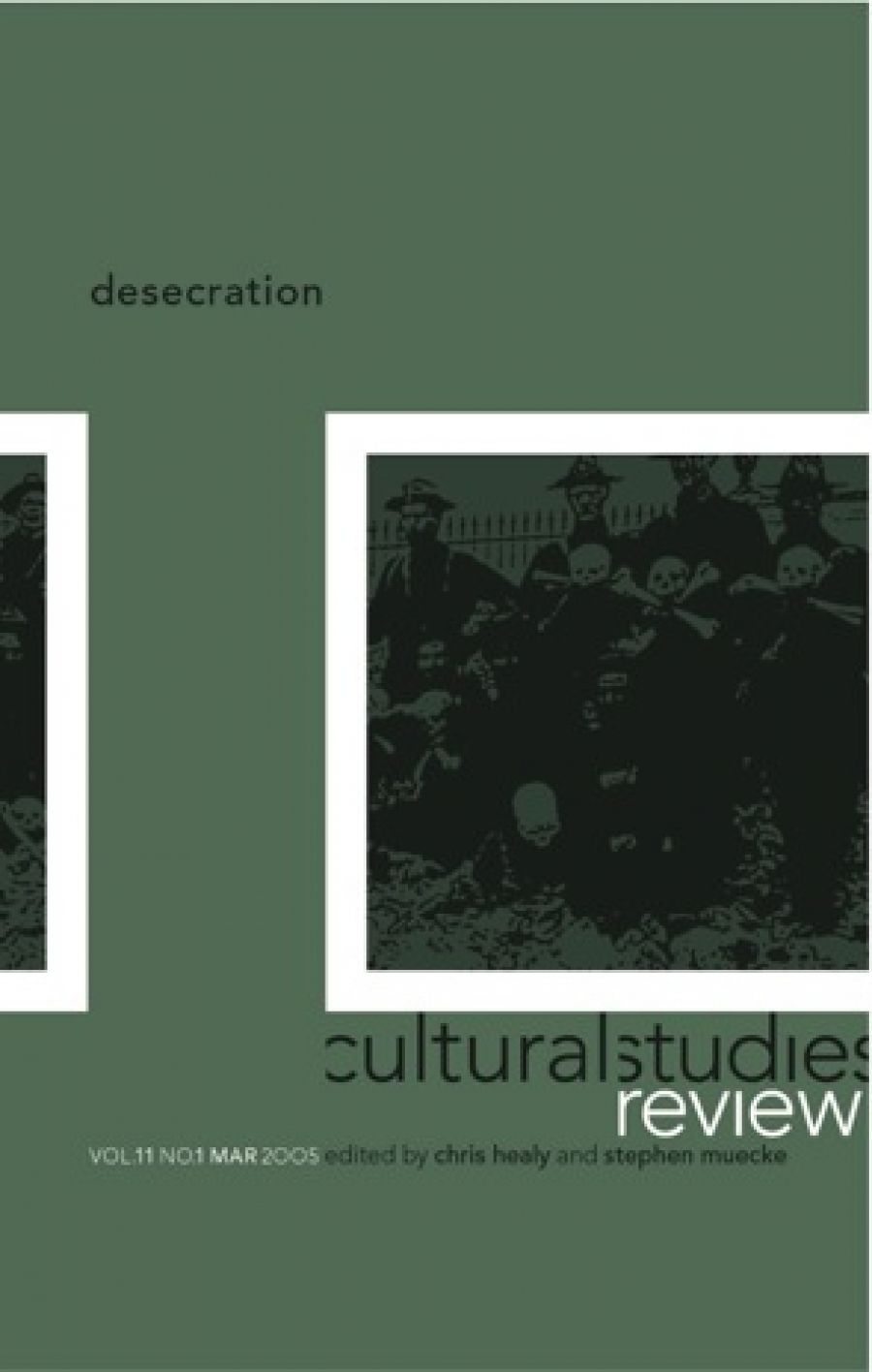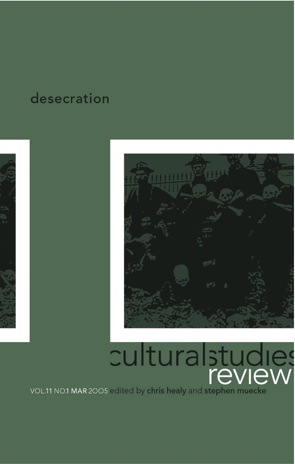
- Free Article: No
- Contents Category: Journals
- Review Article: Yes
- Article Title: Evil empire or fellow citizen?
- Online Only: No
- Custom Highlight Text:
Evil empire or fellow citizen? It seems to me that the arguments and counterarguments about America’s role in the world today run parallel to the debates concerning cultural studies’ standing in the humanities. It’s a thought that would have Raymond Williams rolling in his grave, of course. As an academic discipline, cultural studies was born Marxist, and reared to champion the local, the underdog, the oppressed. But intervention of all kinds, good and bad, is a form of influence. Act on behalf of others and for every round of applause, there’ll be a competing cry of indignation. Perhaps I should declare my hand? I’ve been in and out of English departments for the last fifteen years. I feel a sense of overwhelming gratitude to cultural studies for loosening literature from New Criticism’s explication de texte. That said, I mourn the loss of a community of readers that the canon – and the existence of English departments, discrete unto themselves – ensured. I also baulk at the idea that readers are mere consumers – that catch-all term – as if curling up with a novel was experientially no different to eating, shopping or watching television.
- Book 1 Title: Cultural Studies Review
- Book 1 Subtitle: Desecration vol. 11, no. 1
- Book 1 Biblio: $25 pb, 232 pp
- Book 1 Cover Small (400 x 600):

- Book 1 Cover (800 x 1200):

- Book 2 Title: Australian Historical Studies
- Book 2 Subtitle: vol. 36, no. 125
- Book 2 Biblio: $30 pb, 189 pp
The latest issue of the Cultural Studies Review is entitled ‘Desecration’, and at least a couple of its contributors display a willingness to turn an interrogative spotlight upon the discipline itself. Gary Wickham, for example, contends that cultural studies’ commitment to the politics of empowerment is more self-sustaining mythos than mindful enterprise. However, his appeal for help from Epicurus, Hobbes and others reads more like complicated mumbo-jumbo than material solution. Likewise, Marcus Breen’s dispatch from the inner sanctum of the US cultural studies scene promises a full-blown exposé, but turns out to be much more tease than strip. The first three pages are frittered away filling us in on the author’s cardiological history, with a superfluity or two on the flip-flop of Christopher Hitchens thrown in for good measure. The remainder is a dog’s breakfast of equivocations, non sequiturs and part-revelations, seasoned by occasional phrasal flatulence worthy of Alan Sokal’s hoax back in 1996. One wants to be sympathetic to the sick, but it’s hard to forgive someone who describes getting on in years as a ‘post-mortality sensibility’ and ‘a transhistorical point of view’. In contrast, Maria Tumarkin’s meditations on the ethics of representing other people’s pain packs a plain-speaking intellectual punch in fewer than six pages. The essay showcases the sinews of the interdisciplinary approach that is cultural studies’ raison d’être.
The majority of the other contributions are more cocksure about cultural studies’ powers as tool, not weapon. Martin Ball’s ‘The Pleating of History’ comes closest to declaring war on the methodology of a traditional discipline. His central contention – that Gallipoli ‘provided the folds needed to pleat’ Australia’s ignominious past into ‘the story of nationhood’ – does not proceed from an examination of the campaign itself but, instead, from a wholesale commitment to the metaphor of ‘history as fabric’. The aptness of the analogy is tirelessly elaborated, and considered in relation to competing theoretical accounts of history. Accordingly, the essay reads as learned and persuasive. Nicola Evans’s suggestion that sensational trials such as the O.J. Simpson and Menendez brothers cases reveal ‘the unwritten codes of the quotidian’ is equally compelling. The essay shows all the signs that it will do what cultural studies does best: reveal the significance of the everyday stuff that the rest of us dismiss. However, Evans fails to leave us with a final mugshot of normalcy that details such as Mr Menendez’s penchant for caviar apparently disclose. I did find it curious, though, that the issue’s best contribution – Ross Chambers’s consideration of the Dr Jekyll– Mr Hyde motif in Peter Carey’s My Life As a Fake, and the novel in general – wouldn’t have looked awry in any strait-laced literary journal. His claims about the constellation of concerns that accompany ‘identitarian splits’ in narratives are up to his usual high standards. But it is his patient elaboration of the reader–writer relation in light of this theme that is positively virtuosic.
Chambers’s inclusion in the issue proves that the parochial UTS days of the Cultural Studies Review are over, but that it still cultivates an antipodean flavour. The serving size this issue is generous, and the range of topics and books reviewed is unquestionably cornucopian. Despite any reservations I may have had from time to time about the discursive tendencies of some contributors, the journal’s editors appear to do everything in their power to provide variegated scenery for their readers. The journal has strong claims to being the leading forum for academic cultural studies in Australia.
Australian Historical Studies was twenty-three volumes old when Richard Hoggart opened the first cultural studies unit at the University of Birmingham in 1963. How has it weathered its consequent storm? Cultural studies says you can tell this kind of thing from a cover. If so, lying next to the Cultural Studies Review, it looks rather grim – an impression the gloomy innards of Old Melbourne did little to dispel. But I’m pleased to report that you still can’t judge a book by its cover, for Australian Historical Studies is one of the liveliest 65-year-olds in the country. The issue begins with four articles that address the impact of global politics on the Australian scene between 1933–61. An old-fashioned ‘feats of princes’ view of history is in evidence. ‘Politicians, bureaucrats and intellectuals’, as editor Joy Damousi says, are the focus, but the material is all the more fascinating because of it. John Perkins, for instance, tells the remarkable story of how Australian wool came to clothe the whole of Nazi Germany, from the ‘Brown Shirts’ to the Bund deutscher Mädel. Also arresting is Fay Anderson’s account of the 1961 Social Studies Affair at the University of Melbourne, one of Australia’s lesser-known episodes of McCarthyism on campus. In telling her story about a departmental personality clash cum Communist witch-hunt, Anderson shows how the broader anxieties of an age can disfigure everyday life narratives. The article also paints a slightly less shiny portrait of the eminent historian Max Crawford, one that can only be confirmed or denied in 2021 when Anderson gets her hands on his ‘voluminous’ archival collection.
But so much for the cool eye of old-school history; it is in the journal’s ‘Forum’ and ‘Historical Overview’ sections that the reader gets wise to cultural studies’ beating heart. Its pulse is strongest in Jacqueline Z. Wilson’s deliberations on the recent reinvention of Pentridge from H.M. prison to $20 million ‘piazza’. While developers have gone about the business of inoculating the violent history of the site, Wilson looks to doctored billboard advertisements and jailhouse graffiti to preserve it. The piece reminds us that ugly episodes deserve memorialising, too, and that history thrives only when tended to by many masters. It makes gripping reading. Helen MacDonald also zeroes in on an unsavoury chapter in Tasmanian history. Her retelling of the infamous dissection of the last Tasmanian Aboriginal, William Lanney, is immensely readable, despite the grisly subject matter at hand. And in a timely piece of Anzac remembering, Anne-Marie Condé treats the World War I archives of the Mitchell Library and the Australian War Memorial to anatomisation. Archives, after all, do not collect themselves, and Condé goes to great pains to explicate the personalities and policies that were responsible for gathering the raw ingredients of our collective history. The ‘Reviews’ section is ample, and the journal leaves an overall impression that it has served to fill many gaps in Australian history’s body of knowledge. Evil empire or fellow citizen, then? If the latest issues of Cultural Studies Review and Australian Historical Studies are any guide, cultural studies is doing a better job revivifying its confrères in the humanities than ‘doing’ cultural studies itself.


Comments powered by CComment